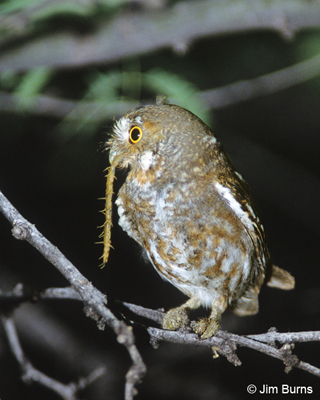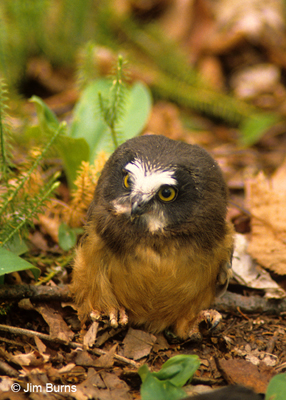
My friend is feeling it too. A nature photographer first, but getting interested in the birds he photographs, he is sitting out the latest storm, at home, going through old photo files and sending me images of birds he has captured but cannot identify. I feel his pain and begin surfing through my own files, seeking some spark. “Night Moves?” Ah, sure. I scroll down into my owls. “Workin’ on mysteries without any clues?” You bet!
I never drove a ‘60 Chevy, but I do still have the dark haired beauty with big dark eyes who accompanied me on countless owl missions, the most memorable those where we found our lifers. First in mind is always our last seen of the nineteen North American owls, the only small species whose dark eyes match hers. Probably last seen because it is only the size of a sparrow and the rufous highlights of its facial disc and scapulars blend perfectly into the reddish interstices of the Ponderosa bark, its favored habitat.
High in the Chiricahuas well after dark, we ignore the splashing in the nearby creek because we have just heard the low, soft, maddeningly ventriloquial “Boo-BOOT” of a Flammulated Owl and are desperately trying to locate it. Here! No, there! Is it moving or just turning its head? The literature says the calls are closer and lower than they seem. Splaying the flashlight through the pines, we can’t believe we are finally this close but can’t find it!
Suddenly the increasingly obvious commotion emanating from the creek penetrates the wall of our owl intensive obliviousness. We glance at one another in simultaneous awareness. Recognition, chagrin, and alarm flow in rapid sequence. “Bear!” We lock arms and run, backwards, as I splash light high in the pines and low over the creek, fifty yards to the van and collapse into the open door, laughing uncontrollably. No owl. No bear. We wouldn’t get our first Flammy until the following summer.
I continue scrolling and pause on the screech-owls. I remember our first Whiskered Screech-Owl. Back then we were using tapes, but only judiciously. Play a few seconds, then listen. Wait a few minutes, then try again. Three times max, then move on. We are in an area that, to this day, we call Secret Canyon because we have never divulged its exact location in the Coronado National Forest. We have missed this owl on several occasions and are trying a new strategy--into the sleeping bags early, but with the alarm set for midnight.
Groggy with sleep as we crawl out of our bags, we inadvertently knock the tape recorder out the door of the van. The “play” switch lands just right, on a rock, and the “Morse code” hoots of a Whiskered emanate from the recorder and fill the clearing. I hurriedly hit the “off” button and we listen. Nothing. I hand her the recorder and she plays it again. Still no response. “One more time” I say. Crickets, but no owls. Then the tape begins again. Very close! I turn to her and say “That’s probably enough. Turn it off now and we’ll try another area.” She looks at me, big grin on her face, and whispers heatedly, “It IS off!”
Shapes materialize, moving shadows alight, Morse code fills the air. At one point that night we see five different Whiskereds! We have camped, apparently, at the intersection of two territories with pairs still sorting things out amongst themselves and unmated singles. Unforgettable!
Our first visual encounter with an Elf, the world’s smallest owl by the way, is equally memorable, but for a different reason. Following up a rumor we hear from a birder who knows another birder . . . . we find ourselves in the side yard of a stranger in the foothills near Tucson, skeptical that we would see the Elf pair supposedly using the hole in the huge Saguaro before us. Within minutes skepticism turns to wonder as we watch the parents bringing a cornucopia of night insects to the begging young every ten to fifteen minutes.
Their menu features moths, beetles, centipedes, crickets, spiders, and some creepy crawlies we cannot identify. The main course, though, is scorpions and Vinegaroons. This lesson in natural history unfolds before our disbelieving eyes over two hours, accompanied by the familiar high pitched barking of the adult birds. We’ll never again dismiss owl rumors. Aren’t owls and rumors synonymous?
My mind, and the mouse in my left hand, go to one final, lasting memory of our small owls. Northern Saw-whet is the Arizona owl for which we have the fewest sightings. We have never attempted to tape this species, and we have never heard it vocalize, but we have held one in our hands! And we have seen one make a kill, so perhaps the richness of our Saw-whet experiences exceeds that of all the other owl species.
Decades ago while searching for Kirtland’s Warbler in northern Wisconsin we stumbled upon a bird researcher surveying breeding species. He promises something he thinks we’ll appreciate, and we follow him through the forest to a nest box from which he hands my wife a young Saw-whet, one week from fledging. The wonder and delight on her face turns to wonder and anxiety as the tiny owl instinctively tightens down on her finger with both talons. It does not draw blood, but the marks remain the next day.
Four summers later we are in the Ruby Mountains of Nevada, putting up a tent when a robin flashes by, brilliant in the setting sun, and disappears into a Ponderosa Pine next to the campsite. Minutes later, returning with the ice chest, I glance up to a low horizontal branch overhanging the picnic table and see, not a robin, but an immature Saw-whet in its bright rufous plumage, studying me impassively.
We slowly and quietly spread our dinner in the dying light, the owl never moving. As we finish up, some lower threshold of light triggers some higher threshold of its owlness. The yellow eyes begin tracking movements we cannot see, the head begins to swivel tracking sounds we cannot hear. It sweeps past us, suddenly, and stoops near a stump not ten yards from our table. One high squeak, a small commotion, then stillness. Morning light reveals the body of a vole, headless, near the stump.
I hear the thunder. How far off I sit and wonder. But I have the spark now. Tomorrow I’ll be somewhere afield, monsoon be damned. Birds have to eat, especially now during autumn migration, and I have to be out looking for them. I email my friend, identify the latest image he has sent, and remind him we have never photographed a bird while sitting in front of our computers.